Each backpacking trip you take will require a different combination of clothing, gear and preparation, but the core components of any adventure in the backcountry are essentially universal (with small tweaks here & there depending on location, weather, & duration.) To help you pack & prep for your next (or first ever!) backpacking trip, we have put together a complete checklist of everything that you will need in addition to some extra recommendations of our own.
Travis (aka the Gear Master) has spent hours & hours of research finding & testing out different outdoor gear & clothing in order to find the best products to enhance our outdoor experience. If you have any questions about the gear we use & recommend OR if you have your own suggestions for better options – please reach out or leave a comment!
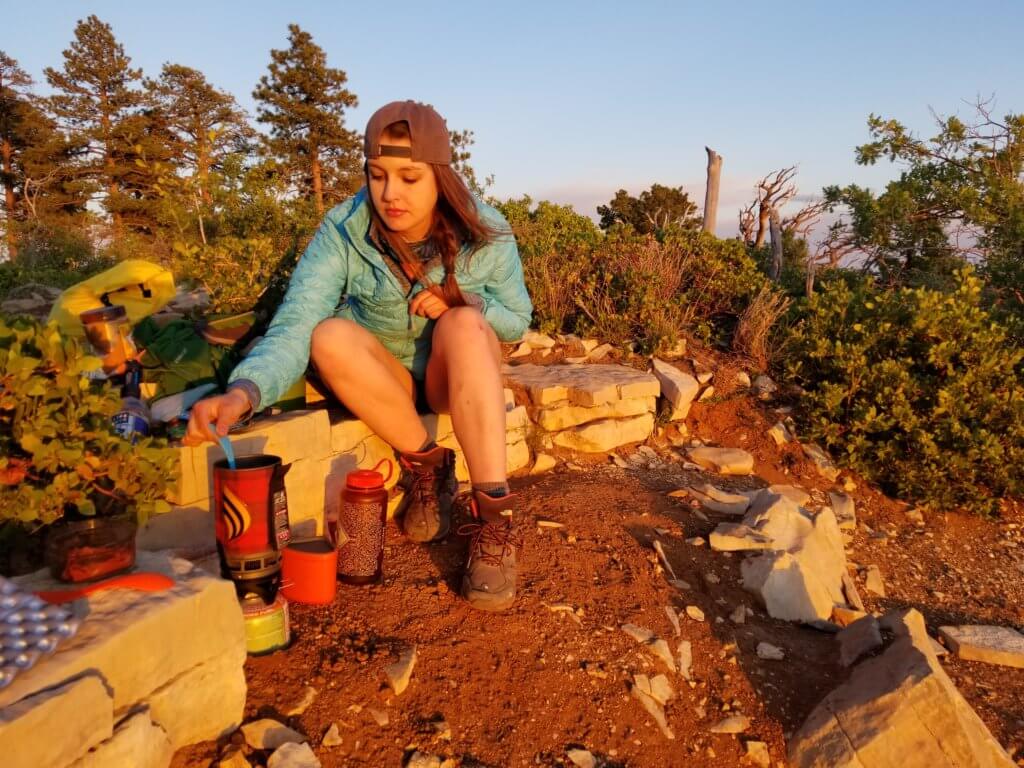
The Official Backpacking Packing Checklist
Whether you’re a complete backpacking newbie or seasoned backcountry veteran, you will need the same basic gear. The below list outlines the essential components you will need for each backpacking trip – as well as some ‘non-essential’ comfort/variable items. You definitely don’t want to (and probably shouldn’t) carry every single one of these items with you on every trip you take – so carefully pick & choose the items you actually need from this checklist. Either way you’ll be prepared, but if you aren’t selective about the gear you grab, you will have a SUPER heavy pack & likely a miserable time on the trail. We had to go on a few trips to learn this lesson the hard way, the very hard way.
Within the checklist we have also provided links and descriptions of our favorite backpacking products that we can’t live without & highly recommend. We still use & pack all of the un-linked items as well, but do not have a strong preference about the features, style or brand.
As a disclaimer, this packing checklist contains affiliate links – which just means that we get a small commission off of any sales generated from the links clicked on Travanie Travels. There is absolutely no additional cost to you for clicking or using our links – but it does provide us with a small income that definitely helps us out!
For a printable version of our go-to packing checklist from REI, click here.
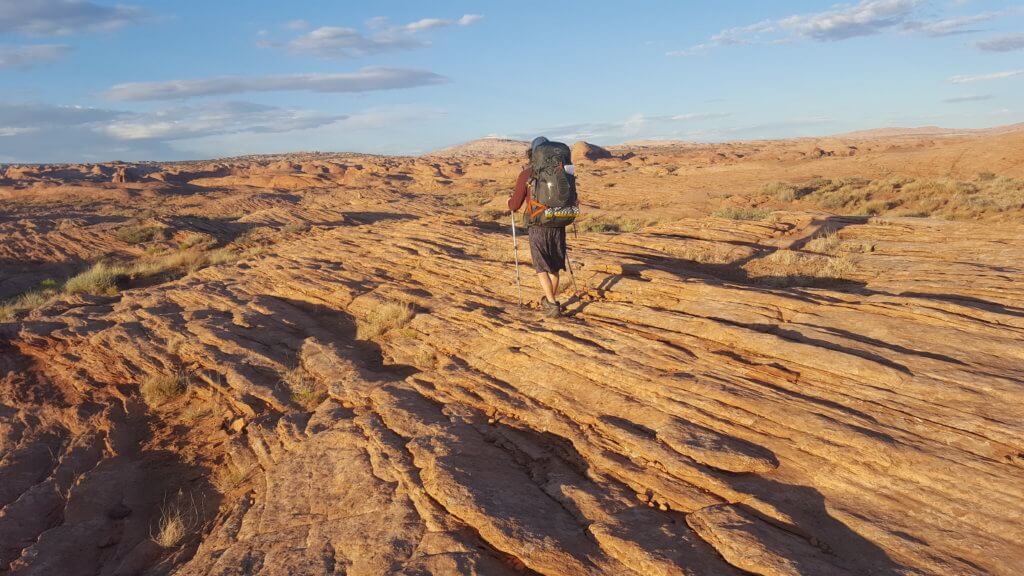
Table of Contents
- Backpack
- Shelter
- Sleeping
- Clothing
- Cooking
- Food
- Water
- Electronics
- Toiletries & Hygiene
- Emergency & First Aid
- Navigation
- Personal Items
- Miscellaneous
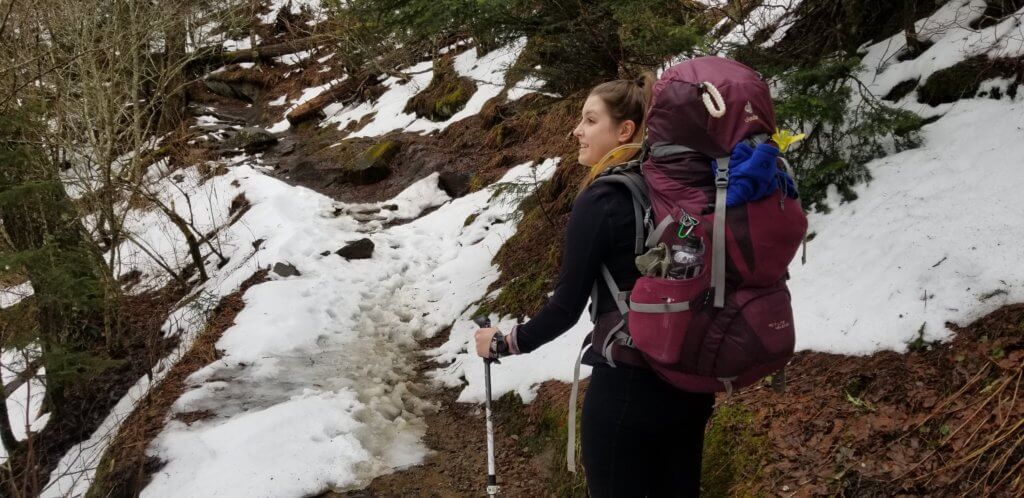
Backpack:
First thing’s first, if you’re going on a backpacking trip – you’re going to need a backpack. If you don’t have one, we highly recommend going to your nearest REI store to spend an hour or two with a store employee getting properly fitted & then testing out different brands, models, and styles of backpacks to find the one that fits you best. If you’re nearest REI is a few hours away – make a day trip out of it! We literally spent 3 hours testing out & trying on packs before we finally committed to purchasing them.
- Stephanie: Deuter ACT Lite 45+10
- Loved this backpack for the universal size and the ability to expand 10 liters. I ultimately purchased for the style, features, and super-comfortable fit.
- Travis: Osprey Atmos 65 AG
- Chose this pack because of its perfect fit & breathability but also loved the “perfect amount of extras” with the featured interior compartments & stretchy pockets.
Shelter:
For a backpacking shelter you have a few options depending on your route – tent, hammock, or space in a shelter if you’re traveling along a trail that has them. While traveling as a couple, we usually prefer to bring a tent so we can share the weight. However, a hammock system is a great alternative to sleeping on the ground – just check beforehand that there are an ample amount of trees wherever you are going!

One/Two Person Tent
- Tent
- Tent Poles
- Stakes
- Footprint
- Tarp (if expecting inclement weather)
We currently use the Mountain Smith Morrison 2 Person Tent and love its style, size, and versatility. Its a great starter tent but however we are on the hunt for a upgrade that is more lightweight & better suited toward backpacking.

- Hammock
- Straps
- Rain Fly
- Stakes
- Bug Net (if needed)
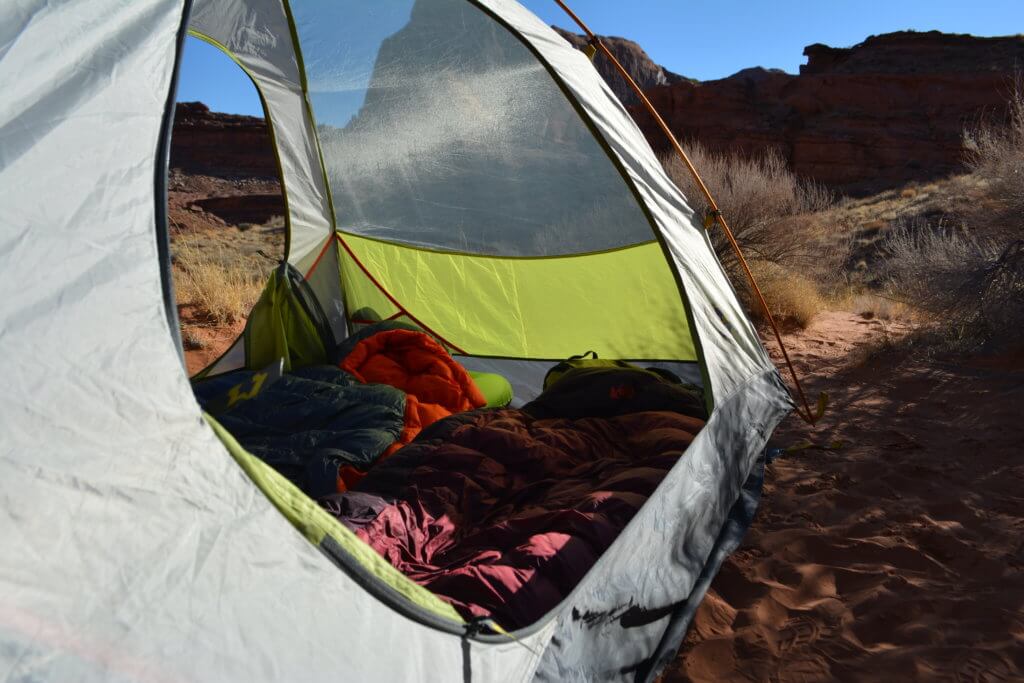
Sleeping:
Comfortable & warm sleeping gear is essential to getting a good night’s rest on the trail. Like backpacks, sleeping bags & pads are something that you should take your time researching to get the most out of your backpacking trips. High-quality sleeping gear is something that’s definitely worth the investment.
- Sleeping Bag
- Stephanie: REI Co Op Joule 21
- Stephanie chose this mid-degree down sleeping bag for its warmth, packability, and material as well as its versatility to use in all seasons. In the late fall & winter she just tucks a lightweight down blanket into her sleeping bag for extra warmth.
- Travis: REI Co Op Magma 15
- Travis chose this down sleeping bag for its soft material & fitted profile as well as its great warmth to weight ratio.
- Stephanie: REI Co Op Joule 21
- Sleeping Pad
- Klymit Static V Insulated Sleeping Pad
- We both prefer having an inflatable sleeping pad for its light weight & packability. The Static V rolls up fairly small for a fully body pad & can be inflated quickly & easily on the trail.
- Therm-A-Rest Z Lite Sol Sleeping Pad
- We usually pair our Therm A Rest pad with our Static V for winter camping, but many people actually use it as a stand alone pad. It’s greatest feature is that it can’t deflate throughout the night or get a hole in the middle of the trip.
- Klymit Static V Insulated Sleeping Pad
- Inflatable Pillow
- Even as an aspirational ultra-liter, Travis will not go on a backpacking trip without a pillow. He doesn’t have a brand preference of camping pillow – but swears that just having one, any one, will enhance the trip ten-fold.
- Compression Sack
- Stephanie, on the other hand, just uses a compression sack stuffed with her day clothing. It’s a great option if you’re back is either overfilled or overweight (as hers usually is).
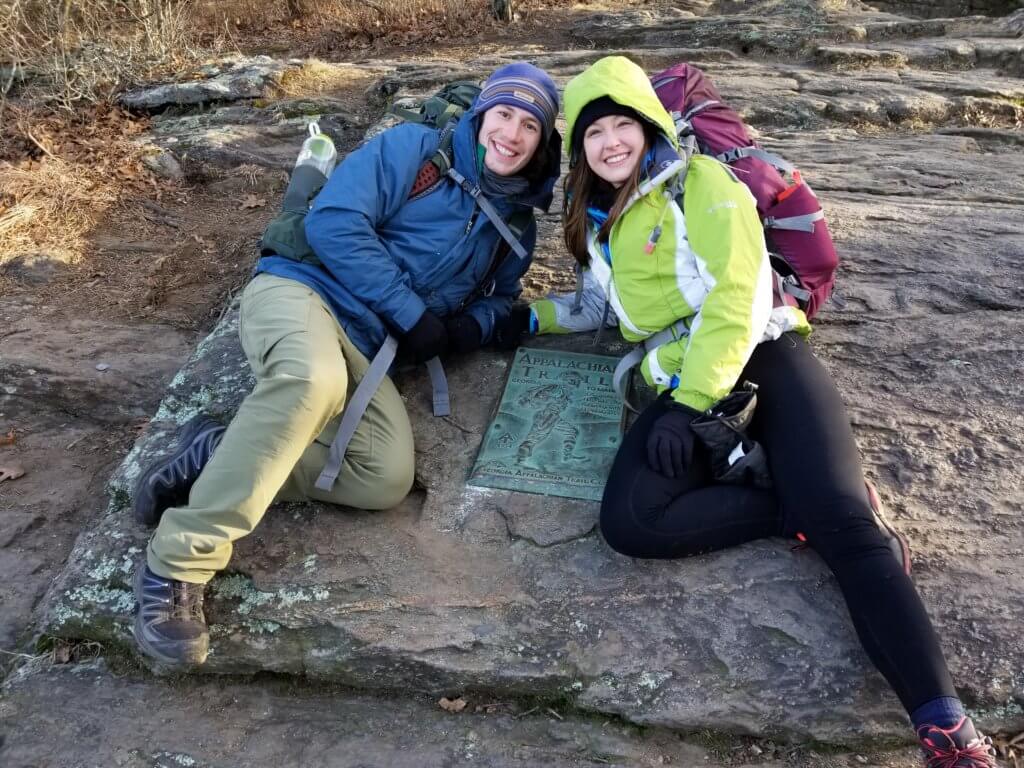
Clothing:
The clothing items you wear & pack will change & vary for every single trip you take. Frequently check the weather forecast before you leave and evaluate which items you will need for each possible weather condition. It’s important to be thoughtful about your clothing choices to ensure that you’re properly prepared for conditions but not over-packed or overweight on the trail.
To cut down on weight & bulk we usually wear the same active clothing for the duration or our trip – which sounds gross, but its not. We’d just end up getting sweaty & dirty again in 30 minutes even if we did change. We don’t usually bring a full set of extra clothing unless our trip is so long that we need an additional outfit or we see wet weather in the forecast & need a dry set of clothing in case our main set gets soaked.
Check out our winter layering guide for an in depth breakdown of the clothing we bring & wear for cold weather hiking & backpacking trips.
Active Layers
- T-Shirt (dry wick)
- Long-Sleeve Shirt (dry wick)
- Hiking Pants/Leggings (synthetic)
- Lightweight fleece or jacket
- Underwear (1 pair for each day)
- Hiking Socks (1 pair for each day)
- Hiking boots
- Rain Jacket
- Rain Pants
Camp/Sleeping Layers
- Base Layer Long Sleeve Shirt
- Base Layer Leggings
- Sweatshirt
- Puffy Jacket
- Camp Shoes (sandals, or lightweight booties)
Accessories
- Buff (heat and/or cold gear)
- Sunglasses
- Hat (baseball cap or beanie)
- Gloves or Mittens
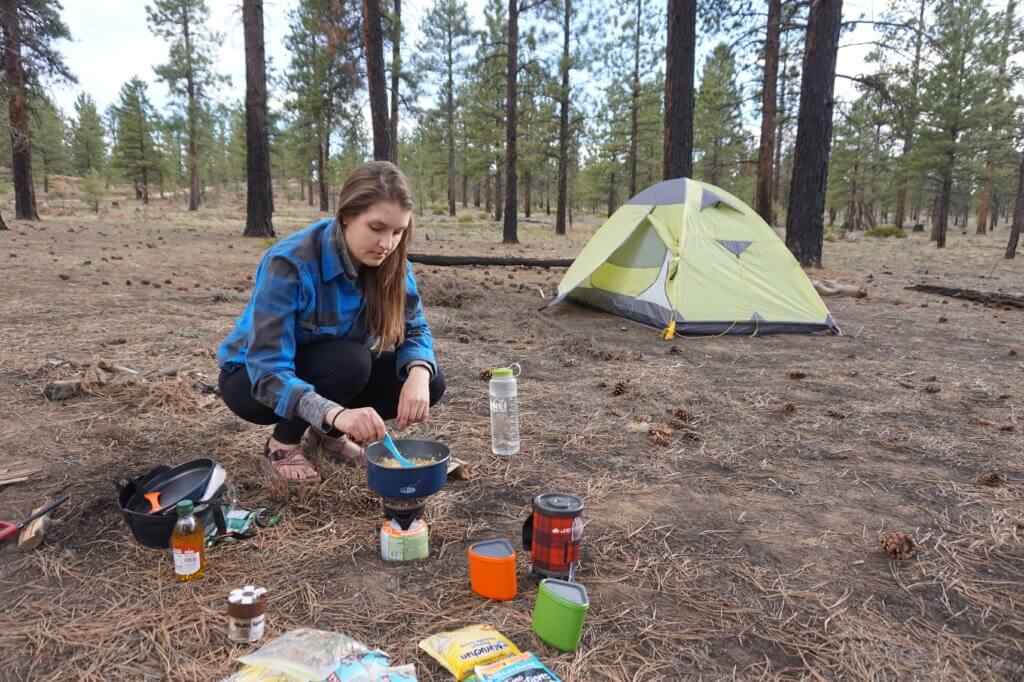
Cooking:
Cooking & food preparation is an essential part of any backpacking trip. A nice, hot meal after a long day on the trail is an irresistible treat that ultimately gives you something glorious to look forward to when starting or ending your day. Even though carrying a stove, pot, fuel, and dishes adds a little extra weight & bulk many backpackers (us included) find it to be a completely justifiable (and necessary) item for ever trip.
- Pocket Stove
- JetBoil Flash
- We love our JetBoil for its self contained packing elements & versatility on the trail. Its super easy to use & convenient for making any meals that need boiling water (oatmeal, pasta, rice, Mountain Meals, etc.) Plus – all of the JetBoil components conveniently pack into the container itself ensuring that the cookset takes up as little space as possible.
- Pot/Pan
- GSI Outdoors Bugaboo Backpacker Cook Set
- We really like this complete cook set – the pot, pan, washtub, and up to four nesting cup/bowl sets are all self-contained in one small package which is ideal for storage & packaging. However, we did find that this set is way to heavy to comfortably carry on a backpacking trip for just two people. We usually bring this cook set when we go car camping or have a backpacking group of 3+people but defer to the JetBoil when its just the two of us.
- Cup/Bowl
- GSI Outdoors Nesting Mug/Bowl
- This has got to be the best backpacking dish set on the planet – the cup packs into the bowl so you get two dishes without taking up any extra space! (this also means that we can have coffee AND oatmeal at the same time in the morning)
- Fuel
- Multi-Use Spoon/Fork
- Knife
- Salt/Pepper/Seasonings
- Biodegradable Camp Soap
- Paper Towels

Food:
Food is hands-down the most enjoyable part of any backpacking adventure. Even instant noodles & packaged tuna tastes like a five-star gourmet meal after a long day on the trail. Since you are pushing & exerting yourself for multiple days in a row, its really important that you bring enough food to fuel your body & replenish the burned calories. (You pretty much have permission to eat as much as you want.)
We usually make a hot breakfast (complete with coffee), snack throughout the day as lunch, and then cook a huge hot meal for dinner. As additional motivation, we also try to bring a special snack as a reward at the end of each day – typically Cheddar & Sour Cream Ruffles for Stephanie and a candy bar or Sour Patch Kids for Travis.
Some of our backpacking food staples include – but are not limited to:
- Instant Oatmeal
- Instant Coffee
- Peanut Butter
- Granola Bars
- Hard Cheese, Salami, & Crackers
- Trail Mix
- Chocolate
- Energy Gummies
- Instant Pasta or Rice
- Tuna Packets
- Dehydrated Vegetables
- Instant Backpacker Meals

Water:
On any backcountry backpacking trip you should have both a primary and backup method of water purification. Thankfully, you can find a vast variety of different purification methods that are both portable & easy to use. We tend to rotate through three different products depending on our trip location & duration. Each purification method has its pro’s and con’s but we happily recommend all of them!
- MSR MiniWorks EX Water Filter
- The best feature about the MSR is that it has a removable & cleanable filter. Once the filter gets clogged and starts pumping slower all you need to do is remove & scrub it. You can do this at home or in the backcounty – which is super convenient if the available water sources have a lot of silt or debris.
- Sawyer Water Filter (Sawyer Mini or Sawyer Squeeze)
- Sawyer water filters are super easy & convenient to use as a bulk filter or as a personal straw. Simply add dirty water to a LifeWater bottle or Sawyer bag & squeeze through the filter. The filter itself lasts for up to 100,000 gallons of water (practically forever) & is back-flushable which makes cleaning it a breeze.
- AquaMira Water Purification Drops
- We use the AquaMira drops whenever we go on a cold-weather camping trip so we don’t have to worry about our other filters freezing & cracking. The drops are also a great “backup” purification source in warmer weather because they are so small & lightweight.
- With the drops, you don’t have to spend time pumping water – just scoop up dirty water, add the drops, & you’re on your way. You do have to wait 30 minutes for the water to be totally purified, but we haven’t noticed the wait time to be a huge inconvenience.
- Water Bladder (2 – 3 Liter)
- Water Bottle (1 Liter)
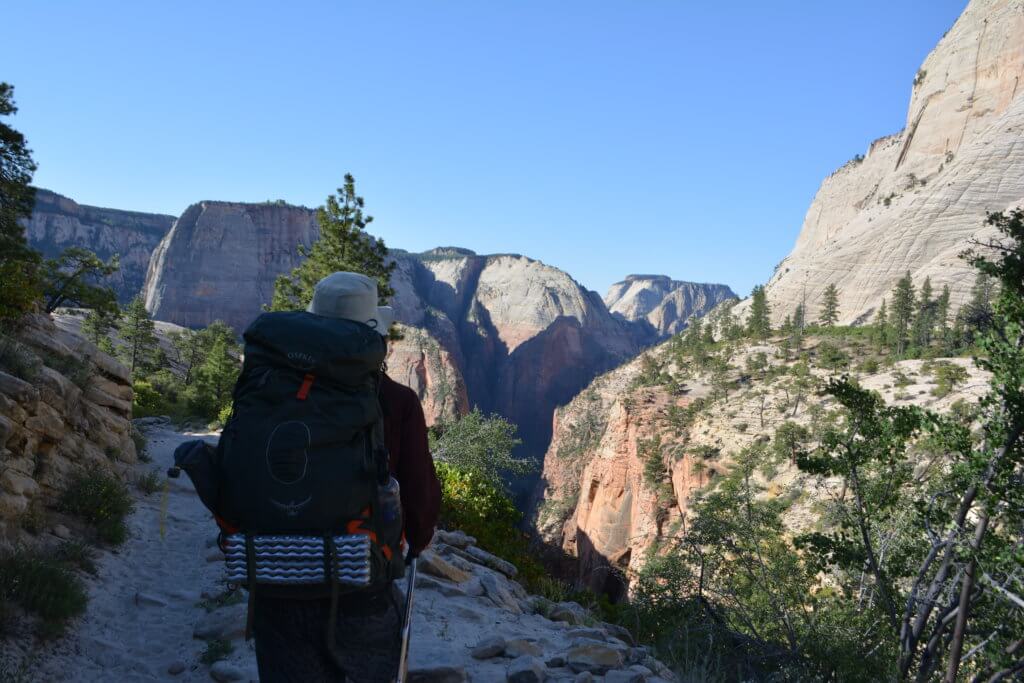
Electronics:
The words “backpacking” and “electronics” usually don’t go together, but whether you’re documenting your trip via GoPro, tracking your mileage with a smartwatch, or using offline maps on your phone to navigate you’re going to need a little something to power up your devices overnight. Even in the great outdoors – you’ll still need a little modern influence.
- Cellphone
- Camera
- GoPro
- Rechargeable Battery Pack
- Charging Cables (phone, camera, watch, etc)
- Headlamp
- Black Diamond SPOT Headlamp
- We both have and LOVE this headlamp for its adjustable brightness, great visibility, and long lasting battery. It’s compact, lightweight & everything you’d ever want/need in a headlamp.
- Extra Batteries
- Coming from a lesson learned the hard way.. ALWAYS have extra batteries on hand for your headlamp. ALWAYS.
- Inflatable Solar-Powered Lamp
- An extra lamp seems a little excessive – but it’s nice to have while setting up camp in the dark or as a mock-fire to sit around in a fire-free area. It’s also a great, lightweight backup should something happen to your headlamp.

Toiletries/Hygiene:
Even though you’re bumming it in the backcountry, it doesn’t mean that you won’t want (or need) to keep up some basic hygiene. The quantity and type of products you bring definitely varies person by person depending on individual preferences. Below is a sampling of all the mini-version hygiene products we choose to bring on our backpacking trips.
- Toothbrush
- Tooth Paste
- Deodorant
- Facial Moisturizer/Sunscreen
- Facial Cleansing Wipes
- Chapstick (with SPF)
- Sunscreen
- Insect Repellent
- Hand Sanitizer
- Toilet Paper
- Bathroom Trowel
- Menstrual Products (if needed)
- Prescription Medications (if needed)

Emergency & First Aid
The motto of any trip into the backcountry is always safety first. Only idiots go into the wilderness without the proper emergency & first aid supplies. Before heading out, double check that your first aid kit is updated & well stocked and add any specialty items you may need for your particular trip.
To save on weight & bulk without sacrificing safety create your own lightweight first aid kit or check out these pre-packaged options.
- Mini First Aid Kit
- Lighter
- Matches
- Fire Starter
- Emergency reflective blankets

Navigation:
A decent portion of backcountry trails are well-marked & easy to follow, but it’s still important to have a reliable means of navigating through the trail networks & wilderness. When they’re available, we prefer to get the National Geographic maps (especially for iconic trails like the AT & PCT) but you can also pick up detailed maps from a park’s backcountry office or a local adventure outfitter.
- Paper Map
- Digital Offline Maps (we love maps.me!)
- Compass
Personal Items:
On every trip, it’s always a good idea to have physical copies of your permits, identification, and a little emergency cash with you. Since you won’t need to access these items very often, tuck them in an interior or zippered pocket deep in your pack so you won’t have to worry about anything accidentally falling out.
- Permits
- ID
- Keys
- Cash

Miscellaneous:
There will always be a random assortment of things you need to pack that don’t necessarily fit into a specific category. Usually these items tend to get forgotten or grabbed at the last minute – hopefully this miscellaneous section helps keep these oddball items top of mind while you pack!
- Trekking Poles
- Rain Cover for Backpack
- Drybag (for electronics, paper, or hanging food)
- Microfiber Towel (for swimming or bathing)
- Bear Spray (if required or preferred)
- Bear Canister (if required or preferred)
- Ziplock Gallon Bags (for garbage)
- Seat Pad
- Rope (for hanging food & miscellaneous needs)
- Notebook/Pen
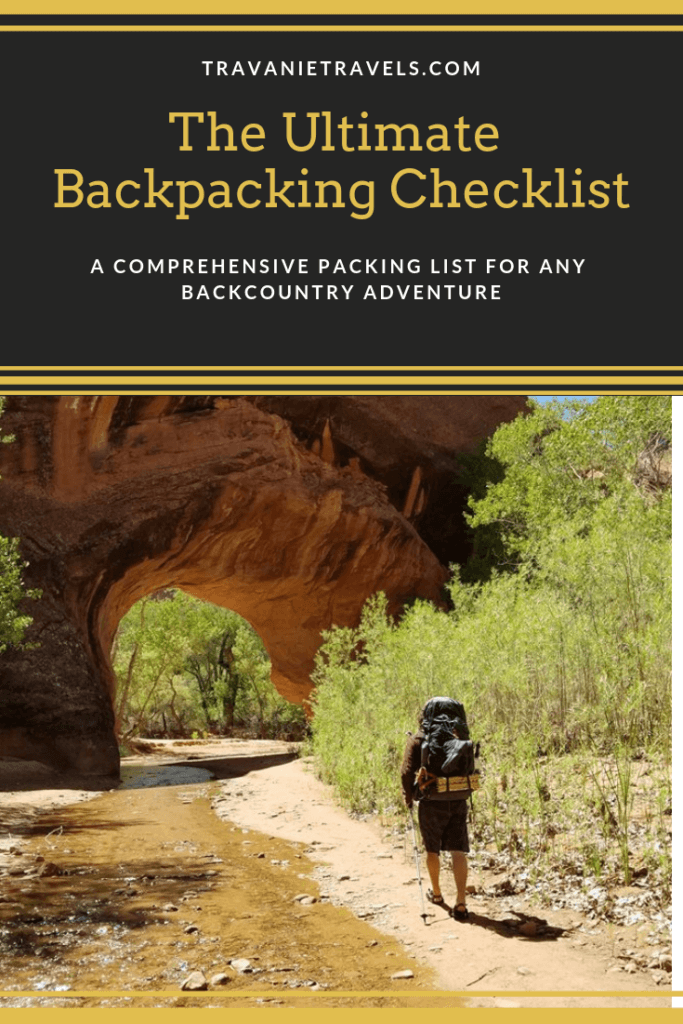
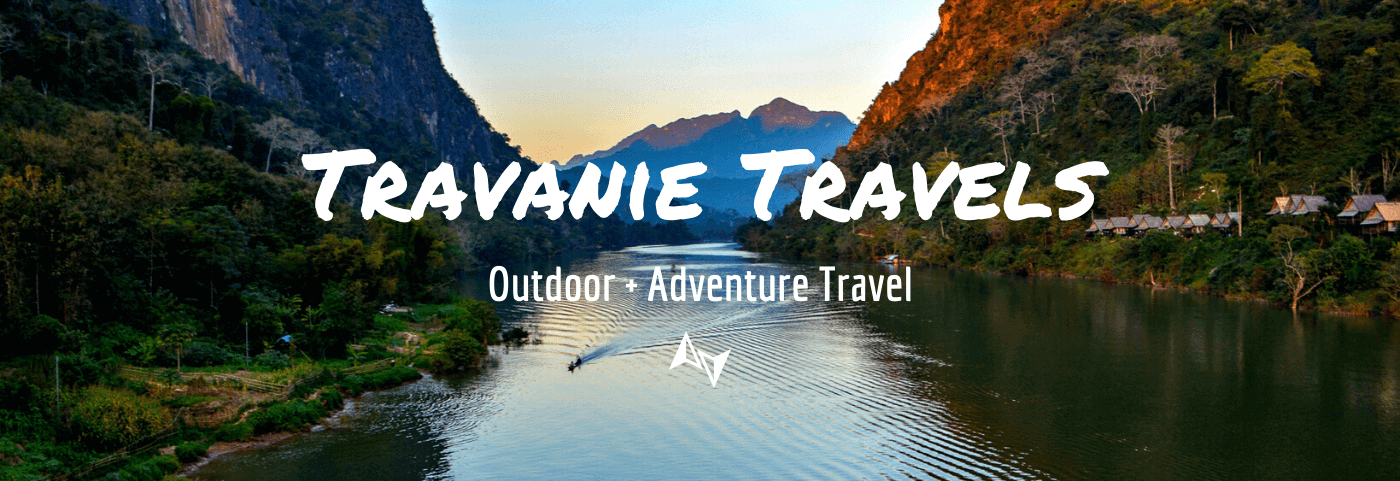

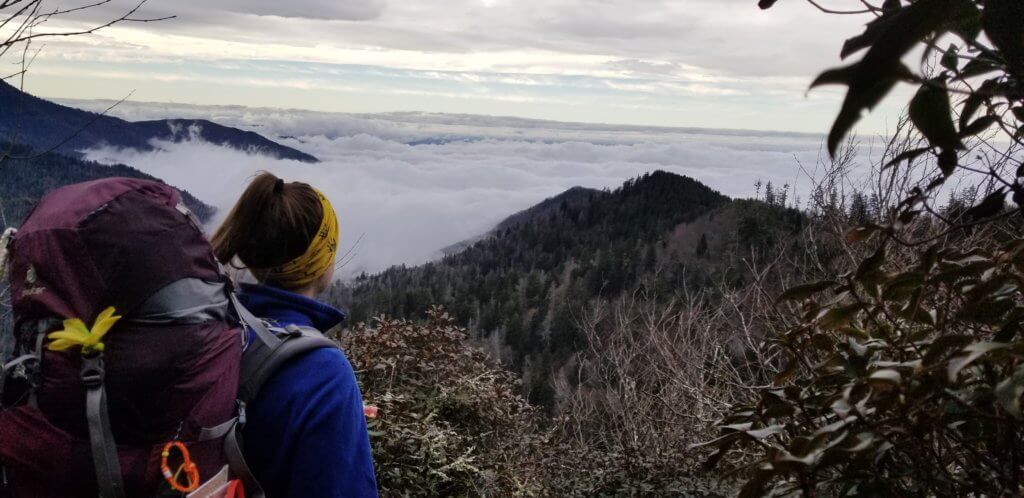



Once again, you’ve “hit it out of the park”.
Pun intended!!
Thanks for reading Jim! 🙂 Glad you enjoyed the post!